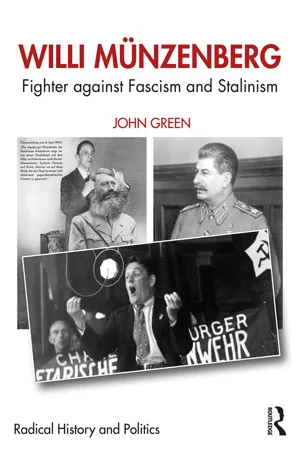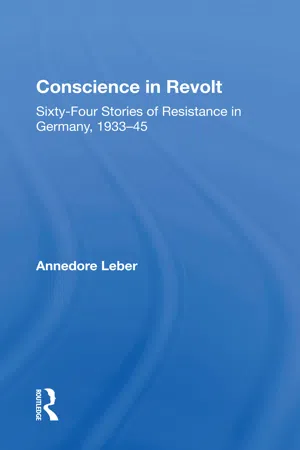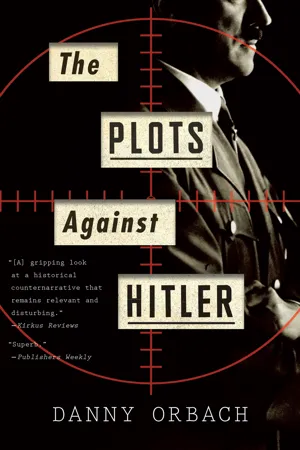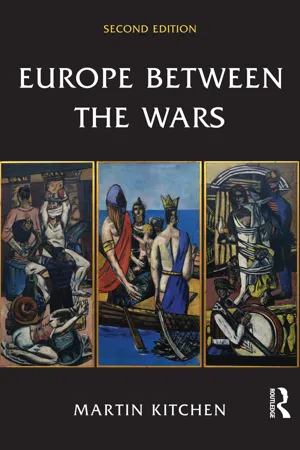History
Reichstag Fire
The Reichstag Fire refers to the arson attack on the German parliament building, the Reichstag, on February 27, 1933. The incident was used by the Nazi Party to justify the suspension of civil liberties and the persecution of their political opponents. It is widely believed that the Nazis themselves orchestrated the fire as a pretext to consolidate their power.
Written by Perlego with AI-assistance
Related key terms
Related key terms
1 of 4
Related key terms
1 of 3
9 Key excerpts on "Reichstag Fire"
- eBook - ePub
Willi Münzenberg
Fighter against Fascism and Stalinism
- John Green(Author)
- 2019(Publication Date)
- Routledge(Publisher)
1The Reichstag Fire was undoubtedly a key moment in Hitler’s bid for total power. It was the tool he desperately needed in order to persecute the Communists, Social Democrats, and other non-Nazi parties and to destroy liberty throughout Germany.Before the fire, Hitler had headed nothing more than a shaky coalition in which the Nazis had only 3 out of 13 cabinet seats. The fire marked the real beginning of what was arguably the most violently destructive regime in human history.Its historical significance is underlined by Carter Hett, when he says that by firmly establishing the truth around the Reichstag Fire and controlling the narrative of how it happened means to control the narrative of everything that followed.2There is little doubt that Nazis committed this criminal act of arson, entering through secret tunnels that led from Marshal Hermann Göring’s nearby residence, but they immediately placed the blame on the Communists in a well-prepared propaganda coup. It was only one month since Hitler became chancellor.3National elections were due to be held in a few days’ time on 5 March, and although the Nazis were already the largest party in the Reichstag, they needed total control to achieve their goals. Over the next days, following the fire, the police, supported by Nazi Stormtroops swooped on all known Communist and Social Democratic offices, as well as their homes, ransacking the buildings, beating and arresting anyone they suspected of being either a Communist, a Social Democrat, or trade unionist. These will be followed by radical Christians and Jews. No one would ever be punished for these acts of terror. The prisons are stuffed with these ‘enemies of the state’, and the first provisional concentration camps are established. The Nazis achieved their aim, and although the Communist and Social Democratic parties were nominally still allowed to contest the elections, they were in effect outlawed, giving the Nazis a free path to total power. Despite the manipulation, however, the Nazis only managed to win 43.9 per cent of the votes, but that did not hold Hitler back. In June, he simply banned the formation of new parties and declared the NSDAP as the only legal party in the country. - eBook - ePub
- Hans Bernd Gisevius, Richard Wilson(Authors)
- 2015(Publication Date)
- Lucknow Books(Publisher)
The symbolism of the event was clear to all. Was it only the Reichstag that was burning? It was far more than that. In the midst of political changes whose effects were already visible everywhere, the flames leaping into the night sky of the German capital signaled the revolution that was about to begin.German parliamentarianism had crumbled inwardly long ago; now its outer shell was collapsing. Of the constitution that had been so solemnly adopted in the National Theater in Weimar in 1919, little more than a sham parliament remained, a parliament that convened simply to carry out noisy demonstrations. Democracy had been done to death long before—had been going downhill since March, 1930, when the Social Democrats overthrew their own chancellor and, with him, the last parliamentary government in Germany. The two following ‘executive cabinets’ under Brüning established the fatal trend toward government by emergency decrees. Thus the deputies of the Left and Center voted their own extinction.The Brown usurpers, who had just come to power in the guise of a ‘legal’ nationalist Opposition, were the last people to object to this trend. They were not interested in tiresome discussion of alternatives nor in impartial estimates of causes. They were not interested in renewing or restoring anything. They wanted revolution. To them the Reichstag building was no more than the ‘gossip club’ of a democracy which they had sworn to destroy.In consequence, the greedy flames were a double symbol. They did more than eliminate a useless parliament building. While the fire consumed the desolate home of the 1918 Republic, it also illumined the beginnings of a new order of things.Everywhere the old order was falling, and its relics bore a strong resemblance to the split and blackened pillars in the assembly hall of the Reichstag. They still stood, but they no longer supported anything. Amid the turbulence of the changing government, frightful forces burst violently into life like a long-dormant volcano. They broke irresistibly through the crust of the old order as though the elements themselves were directly in league with them. - eBook - ePub
The Third Reich
A History of Nazi Germany
- Thomas Childers(Author)
- 2017(Publication Date)
- Simon & Schuster(Publisher)
Variations on exactly how and by whom were myriad, but in this view the Nazi reaction was so rapid and radical that it had to be a Nazi plot, planned and executed as justification for a severe crackdown on the left. No definitive evidence of responsibility for the fire has ever emerged, but much hangs on the interpretation. Some historians have claimed that the Reichstag Fire was part of a Nazi plan to establish the regime’s total domination over state and society, a calculated pretext for the oppressive measures that followed. Among other suggestive evidence, they point to the fact that a tunnel ran from Göring’s office directly to the speaker’s podium in the Reichstag, where, they hypothesize, the blaze began. They also note suspicious comments attributed to various SA men and other party leaders, especially Göring, in the preceding days, as they loudly claimed that the Communists were planning a campaign of public unrest and arson against government buildings. It remains a plausible case. But the most compelling evidence to date strongly suggests that neither the Nazis nor the Communists set the fire, but that, unlikely as it might seem, Marinus van der Lubbe acted alone. But if the Nazis had not planned it, Hitler and the Nazi leadership saw in the Reichstag Fire an unanticipated opportunity for decisive action against the Communists. It was exactly the sort of improvisation that would characterize the first months of Nazi rule—indeed, for much of the Third Reich. The Nazis certainly made every effort to link the Communists to the crime, arresting hundreds of Communist functionaries and formally charging Ernst Torgler, head of the Communist Reichstag delegation, and Georgi Dimitrov, a representative of the Communist International living in Berlin, and two other Bulgarian Communists who happened to be in the city. These actions were not simply for propaganda purposes; Hitler’s fear and rage were not feigned - eBook - ePub
Conscience In Revolt
Sixty-four Stories Of Resistance In Germany, 1933-45
- Annedore Leber(Author)
- 2021(Publication Date)
- Routledge(Publisher)
4THE STATE AND THE LAW DOI: 10.4324/9780429039027-31THE burning of the Reichstag, four weeks after the National Socialists came to power, was their first major act of violence. It was represented as a Communist plot, in an attempt to rally the people to the new rulers by producing a common enemy; and it was used as a pretext for the persecution of large numbers of leading citizens. The Chief of the Berlin Fire Brigade was the first of the experts to question the theory of Communist arson. He was retired from his post at short notice and later ‘removed’ as a troublesome witness. There were many similar cases.The National Socialists’ concern to preserve the legal facade, to transform democracy into dictatorship by ostensibly lawful means, was evident with each move. New laws were made as and when necessary, bogus democratic resolutions were produced, national crises were staged and exploited, always in a manner calculated to show that the law was on the side of the authorities. Thus the ‘Enabling Act’ was wrested from the Reichstag against the background of a wave of terror: the debating chamber was filled and surrounded by SS and SA units and Hitler was prepared to have as many deputies arrested as was necessary to ensure the two-thirds majority. Soon after this the ‘Law concerning the Re-instatement of the Professionally-trained Civil Service’ was applied to secure the dismissal of all politically tiresome or non-aryan civil servants ‘who, in view of their previous political activities, do not appear to be strong supporters of the National Socialist state’. As time went on, politicians who were not Nazis lost all influence and even the ‘Enabling Act’, though it delegated almost unlimited power to Hitler, was overstepped and, like the Weimar Constitution, sank into oblivion.There remained the President of Germany, the highest authority, constitutionally elected, who stood between the nation and extreme arbitrary power. But he was old and ill and had retired to his estate in East Prussia. He was cut off from political life and surrounded by devoted servants of the Führer. - eBook - ePub
A History of Modern Germany
1800 to the Present
- Martin Kitchen(Author)
- 2011(Publication Date)
- Wiley-Blackwell(Publisher)
Volksgemeinschaft ) that would transcend all divisions of class and station. The economy would be revitalized in two successive four-year plans. “National rebirth” would result from reasserting family values and Christian morality. He made no concrete proposals, but he spoke with such utter conviction and passion that the crowds believed that he could be trusted. In this highly charged emotional atmosphere what mattered was not a carefully crafted program, but a spontaneous and passionate reaction. The opposition forces were so hopelessly divided, demoralized, and cowed that they could offer precious little resistance.On February 20 Hitler addressed a group of leading industrialists and told them that this would be positively the last election and that he intended to create a strong and independent state, regardless of the outcome of the election. First he had to gain absolute power, and then he would destroy his opponents. The industrialists were delighted, and promptly got out their checkbooks. The party was thereby relieved of all financial worries.The Reichstag FireAt nine o’clock in the evening of February 27 smoke was seen billowing through the roof of the Reichstag. Shortly afterwards a dim-witted Dutch anarchist, Marinus van der Lubbe, was arrested in the Bismarck Room. He promptly admitted that he had set the building on fire. The National Socialists convinced themselves that this was part of a Communist plot. Their opponents claimed that the Nazis had organized the fire in order to find an excuse to bring in further emergency legislation. The Communists soon published a “Brown Book” that purported to show Nazi complicity in the fire.The Nazi claim that van der Lubbe was under orders from the Communists was soon shown to be utterly false. Communists later admitted that their “Brown Book” was a fabrication. In 1962 Fritz Tobias published a detailed study of the Reichstag Fire and came to the conclusion that van der Lubbe acted alone. Most historians now accept this version, although some respected scholars still believe that the Nazis were implicated.When Hitler was told of the fire he wound himself up into a passion and said that all Communist functionaries should be shot, their Reichstag deputies hanged. The Prussian ministry of the interior promptly set about drafting an emergency decree. On the following day the “Decree for the Protection of the People and the State” was promulgated. All the fundamental rights guaranteed in the constitution were suspended. The death penalty was extended to include a number of crimes, including treason and arson. Summary arrests could be made and the Nazis’ opponents placed in “protective custody” in concentration camps. In an important step towards dismantling the republic’s federal structure, Wilhelm Frick as minister of the interior could disregard the sovereignty of the states if he deemed that law and order were in jeopardy. This decree, which claimed to be solely directed against the Communists, was the fundamental law on which the Nazi dictatorship was based. It remained in force in spite of the fact that van der Lubbe’s trial in September clearly showed that there was no evidence that the Communists were involved. The accused was executed even though arson was not a capital offense at the time he committed the crime. There was a wave of arrests throughout Germany. 100,000 people, mostly Communists, were arrested in Prussia, among them the prominent left-wing writers Egon Erwin Kisch, Erich Mühsam, Carl von Ossietsky, and Ludwig Renn. - eBook - ePub
Hitler's Fall
The Newsreel Witness
- K.R.M. Short, Stephan Dolezel(Authors)
- 2021(Publication Date)
- Routledge(Publisher)
For some time Stalin had been saying, ‘Put the flag of victory above Berlin.’ Whether or not he actually said, ‘And put it on the Reichstag,’ is ambiguous in the Russian text. But as the Reichstag is joined in the text to the command ‘hoist the red banner of victory’, and this is presented as the main symbol of success in the battle, the Reichstag’s conquest became the victory symbol. Soviet authors of the time spoke constantly of carrying out the will of Marshal Stalin, whose motives in making the attack on the city were essentially political and symbolic, and there appears to have been no ambiguity in the minds of the Soviets at the time as to how that was to be accomplished. 2 This choice, of course, was utterly bizarre, but not at all untypical of Soviet wartime behaviour. Not only was the Reichstag properly the symbol of democracy — for which the Soviets claimed to be fighting — under the Hohenzollerns, it was also carried over as the seat of genuine democracy under the German republic which followed the Hohenzollerns in 1918. Moreover, it had been the place of the famous Reichstag Fire of 27 February 1933, the fire which the Nazis blamed on German Communist incendiaries. Using the fire as a pretext to suggest the threat to civil order, the Nazis suspended many of the Communists’ election privileges, invaded and seized their headquarters, and arrested their leaders, virtually on the eve of a hard-fought election campaign whose goal was to secure Adolf Hitler’s place in the Chancellery to which he had only recently been appointed. The Nazis then arrested and publicly tried some of the Communist leaders for their alleged role in starting the fire. This was, no doubt, one of the bits of history known to Comrade, now Marshal, Stalin. He was not a cosmopolitan or well-travelled man - eBook - ePub
- Danny Orbach(Author)
- 2016(Publication Date)
- Houghton Mifflin Harcourt(Publisher)
“They wanted to send armed gangs to the villages to murder and start fires,” noted Luise Solmitz, a conservative schoolteacher, in her diary. 3 “So the Communists had burned down the Reichstag,” wrote Sebastian Haffner, a young jurist and one of the few remaining skeptics. That could well be so, it was even to be expected. Funny, though, why they should choose the Reichstag, an empty building, where no one would profit from a fire. Well, perhaps it really had been intended as the “signal” for the uprising, which had been prevented by the “decisive measures” taken by the government. That was what the papers said, and it sounded plausible. Funny also that the Nazis got so worked up about the Reichstag. Up till then they had contemptuously called it a “hot air factory.” Now it was sud denly the holy of holies that had been burned down. .. The main thing is: the danger of a Communist uprising has been averted and we can sleep easy. 4 Neither the government nor the Communists were sleeping easy. On the eve of the Reichstag Fire, Hitler had yet to win support from the majority of Germans. The National Socialist Party was still far from a Reichstag majority. The opposition parties from the left, the Social Democrats and the Communists, were still major political powers. 5 Now, the Nazis used the red scare to rally large parts of the German public to their cause. Many people, even if cold to Hitler and his radical ideas, began to consider him the lesser evil. Others, especially adherents of the National Conservative right, turned to the Nazi leader as a redeemer. The teacher Luise Solmitz, though married to a converted Jew, was one of them. “The feelings of most Germans are dominated by Hitler,” she confided in her journal. “His fame rises to the stars. He is the savior of a wicked, sad world.” 6 The fears of the public were exploited to kick off a half-planned, half-improvised campaign for total political, cultural, and ideological subjugation of Germany - eBook - ePub
West Germany
A Contemporary History
- Michael Balfour(Author)
- 2023(Publication Date)
- Routledge(Publisher)
4 The Third Reich, 1933–1945The Totalitarian State
Part of the Nazi technique lay in never allowing their competitors a letup or the German people a dull moment. No sooner was Hitler installed as Chancellor than another election was announced – the third in eight months. The propaganda machine, which now had full access to the radio system, was turned on in full strength (subject only to the discovery that Hitler was a poor speaker in the studio). The storm-troopers, 40,000 of whom were taken on as auxiliaries by the Prussian police, were let loose in the streets. We are unlikely ever to know for certain how the Reichstag building was set on fire on the night of 27 February; it is perfectly possible that the half-witted Dutchman found inside really did the job on his own. What is beyond dispute is the energy with which the Nazis exploited the supposed Communist conspiracy. On the following day, Hindenburg was induced to sign an emergency decree suspending many of the vital personal liberties, authorising the Reich Government to interfere in the Länder and making death the penalty for a number of crimes.But when the Election came on 5 March, the result was far from being the triumph which was represented. 13 million out of 32 million voted for democratic parties and the Communists lost no more than 19 seats; the Nazis only won 43.7 per cent of the poll and were left relying on the Nationalists for a majority in the Reichstag. When it met, the Deputies were presented with an Enabling Bill which would for five years authorise the Chancellor, without reference to the President and irrespective of what might be said in the Constitution, to issue laws on any subject he chose. Only one Deputy (a Social Democrat) spoke against it and only Social Democrats voted against it (the Communists having already been proscribed). Hitler thus made himself dictator by legal methods while the Reichstag abdicated its functions and henceforward only met at intervals to be harangued. - eBook - ePub
- Martin Kitchen(Author)
- 2014(Publication Date)
- Routledge(Publisher)
On 27 February a simple-minded Dutchman, Marinus van der Lubbe, set fire to the Reichstag. Hitler, Göring, Goebbels and Frick promptly announced that this was designed as a signal for a Communist insurrection, which was to be supported by the Social Democrats. With almost paranoid belief in a vast Communist conspiracy, which was widely held among the parties of the right, many Germans became trapped in their own propaganda and believed this to be true. It is certain the KPD had no plans for an uprising, and almost equally certain that had they, they would not have been supported by the SPD. Both the Nazis and KPD made the maximum use of the situation. The Communist propagandist and newspaper publisher, Willi Münzenberg, mounted a skilful campaign from Paris which attempted to prove that the Nazis had organised the fire themselves in order to destroy the KPD, and recent evidence suggests that this version of events may indeed contain a grain of truth, even though the evidence at the time was entirely fraudulent. The controversy over who was responsible for the Reichstag Fire continues, and it is no longer possible to assert with absolute certainly that van der Lubbe acted alone, although the weight of the evidence suggests that he did.On the day after the fire, Hindenburg signed another emergency decree ‘For the Protection of the People and the State’. The decree abolished at one stroke all the fundamental rights of a democratic state: freedom of speech, the right to privacy and the protection of property. It allowed the government to interfere directly in the affairs of the individual states whenever it deemed necessary. Frick, as minister of the interior, was given plenipotentiary power to implement the decree. He decided to give the states a free hand, and then promptly set about banning the KPD’s press, meetings and party organisations. Thousands of party functionaries were arrested, particularly in Prussia, where Göring used these exceptional powers to the full. The Nazis decided not to ban the KDP outright, for fear that the SPD would pick up a large number of extra votes. The decree was also used to step up the persecution of the SPD, in spite of Foreign Minister von Neurath’s suggestion that this might be harmful to Germany’s image abroad. Hitler took no notice of such objections, assuring the foreign press that these measures were purely temporary and were designed to meet a specific threat from the Communists. In fact the Reichstag Fire decree was to be one of the most important steps towards the creation of the Nazi dictatorship. It enabled the party to ignore the normal process of law and destroy fundamental rights and freedoms.
Index pages curate the most relevant extracts from our library of academic textbooks. They’ve been created using an in-house natural language model (NLM), each adding context and meaning to key research topics.
Explore more topic indexes
Explore more topic indexes
1 of 6
Explore more topic indexes
1 of 4








